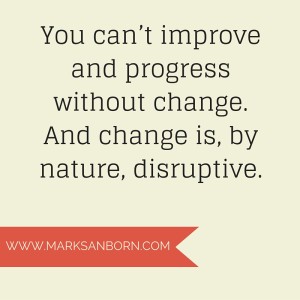In Part 1, I wrote about the need for disruptive leaders who understood the power of positive disruption and the ability to identify what needs to be disrupted.
But remember, you don’t need a title to be a leader, nor do you need a title to be a positive disrupter.
Take Fred Shea, for example. He didn’t just accept the standard for how a postal carrier is supposed to perform his or her role. He looked at the status quo and decided to change and improve it. His example was especially disruptive compared to the never changing way many postal carriers did their jobs. And it happened in an organization that is not known for adding value or making changes.
If you choose to be positively disruptive, you may well open yourself to criticism (usually by those who love the status quo), but as long as your motives are for the good of the organization, this “criticism” is the price of progress. Add a good sense of humor to your commitment to change as a coping mechanism if people take shots at you.
Here are eight ideas about how to be a disruptive leader, even if you don’t have a title:
- In team meetings, ask “what if?” questions. Diplomatically challenge traditional thinking.
- Don’t commit “ideacide:” the killing of an idea before it has a chance to be fairly and fully considered. Examine the pros and cons of new ideas when they are presented by others.
- Recognize and encourage other disrupters for their effort. If they have good ideas, support them in the implementation.
- Be diplomatic but assertive. Resistance is seldom overcome without effort, but it needs to be professional and considerate, not rude or pushy.
- Don’t just model the way, show the way. Demonstrate what positive disruption should look like.
- Become a disruption expert: read broadly and bring in ideas from broad and varied sources. Send links to articles, pictures you’ve taken of good ideas you’ve seen and other resources to your team to stimulate thinking.
- Counsel others on how to improve and implement their ideas.
- Be a mentor to others who desire positive change in your organization.









